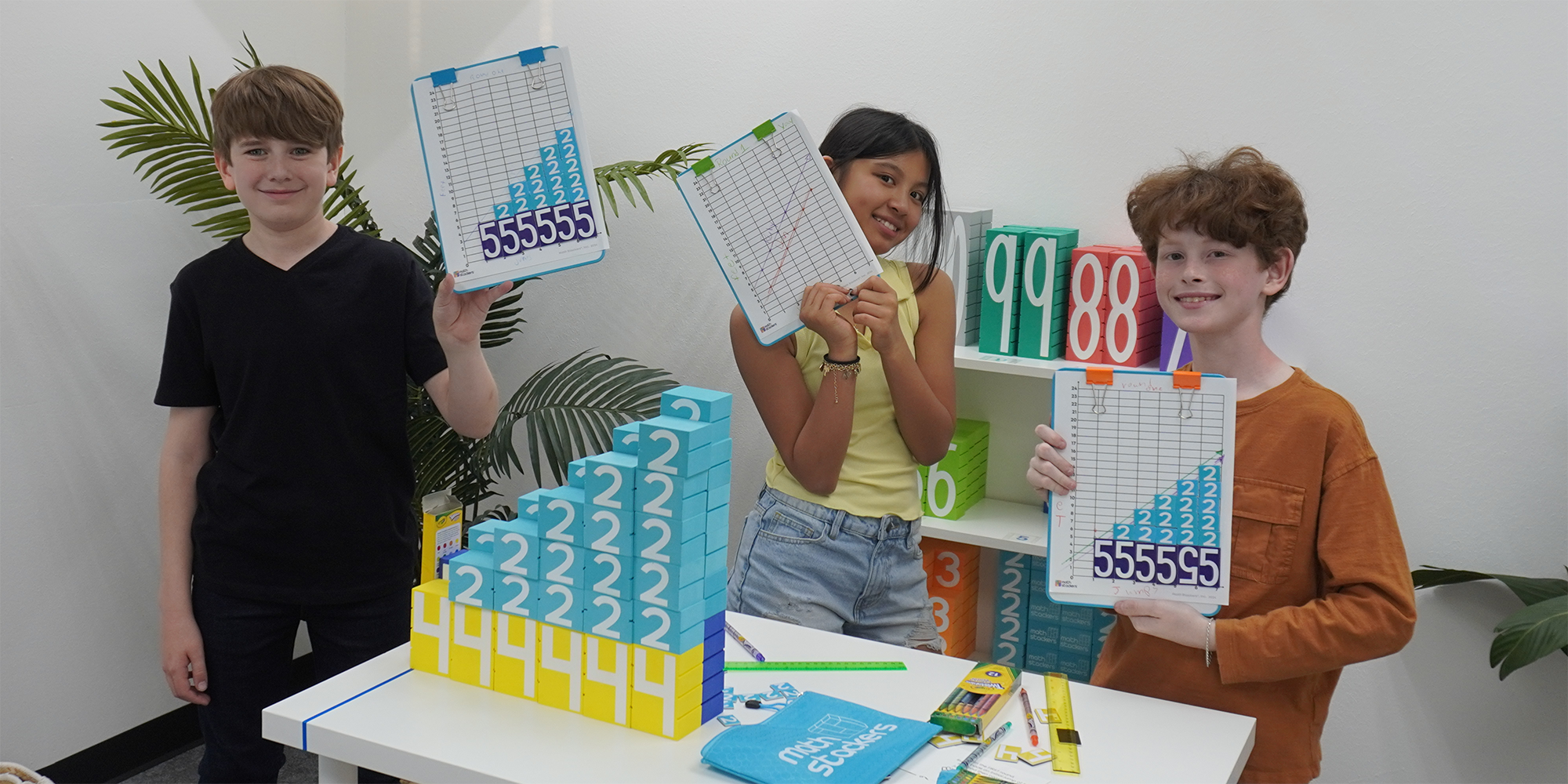*Click above to view standards for 5th grade addition & subtraction, multiplication, & fractions.
TEKS: ADDITION, SUBTRACTION, & DATA ANALYSIS
5.1 Mathematical process standards. The student uses mathematical processes to acquire and demonstrate mathematical understanding. The student is expected to:
- A. Apply mathematics to problems arising in everyday life, society, and the workplace;
- B. Use a problem-solving model that incorporates analyzing given information, formulating a plan or strategy, determining a solution, justifying the solution, and evaluating the problem-solving process and the reasonableness of the solution;
- C. Select tools, including real objects, manipulatives, paper and pencil, and technology as appropriate, and techniques, including mental math, estimation, and number sense as appropriate, to solve problems;
- D. Communicate mathematical ideas, reasoning, and their implications using multiple representations, including symbols, diagrams, graphs, and language as appropriate;
- E. Create and use representations to organize, record, and communicate mathematical ideas;
- F. Analyze mathematical relationships to connect and communicate mathematical ideas;
- G. Display, explain, and justify mathematical ideas and arguments using precise mathematical language in written or oral communication.
5.4 Algebraic reasoning. The student applies mathematical process standards to develop concepts of expressions and equations. The student is expected to:
- E. Describe the meaning of parentheses and brackets in a numeric expression; Supporting Standard.
COMMON CORE: ADDITION, SUBTRACTION, MEASUREMENT & DATA
Operations & Algebraic Thinking:
Write and interpret numerical expressions.
- 5.OA.A.1 Use parentheses, brackets, or braces in numerical expressions, and evaluate expressions with these symbols.
- 5.OA.A.2 Write simple expressions that record calculations with numbers, and interpret numerical expressions without evaluating them. For example, express the calculation "add 8 and 7, then multiply by 2" as 2 × (8 + 7). Recognize that 3 × (18932 + 921) is three times as large as 18932 + 921, without having to calculate the indicated sum or product.
TEKS: MULTIPLICATION
5.1 Mathematical process standards. The student uses mathematical processes to acquire and demonstrate mathematical understanding. The student is expected to:
- A. Apply mathematics to problems arising in everyday life, society, and the workplace;
- B. Use a problem-solving model that incorporates analyzing given information, formulating a plan or strategy, determining a solution, justifying the solution, and evaluating the problem-solving process and the reasonableness of the solution;
- C. Select tools, including real objects, manipulatives, paper and pencil, and technology as appropriate, and techniques, including mental math, estimation, and number sense as appropriate, to solve problems;
- D. Communicate mathematical ideas, reasoning, and their implications using multiple representations, including symbols, diagrams, graphs, and language as appropriate;
- E. Create and use representations to organize, record, and communicate mathematical ideas;
- F. Analyze mathematical relationships to connect and communicate mathematical ideas;
- G. Display, explain, and justify mathematical ideas and arguments using precise mathematical language in written or oral communication.
5.4 Algebraic reasoning. The student applies mathematical process standards to develop concepts of expressions and equations. The student is expected to:
- A. Identify prime and composite numbers;
- B. Represent and solve multi-step problems involving the four operations with whole numbers using equations with a letter standing for the unknown quantity;
- E. Describe the meaning of parentheses and brackets in a numeric expression; Supporting Standard.
5.7 Geometry and measurement. The student applies mathematical process standards to identify locations on a coordinate plane. The student is expected to:
- B. Describe the process for graphing ordered pairs of numbers in the first quadrant of the coordinate plane; and
- C. Graph in the first quadrant of the coordinate plane ordered pairs of numbers arising from mathematical and real-world problems, including those generated by number patterns or found in an input-output table.
COMMON CORE: MULTIPLICATION
Operations & Algebraic Thinking:
Write and interpret numerical expressions.
- 5.OA.A.1 Use parentheses, brackets, or braces in numerical expressions, and evaluate expressions with these symbols.
- 5.OA.A.2 Write simple expressions that record calculations with numbers, and interpret numerical expressions without evaluating them. For example, express the calculation "add 8 and 7, then multiply by 2" as 2 × (8 + 7). Recognize that 3 × (18932 + 921) is three times as large as 18932 + 921, without having to calculate the indicated sum or product.
Number & Operations in Base Ten:
Perform operations with multi-digit whole numbers and with decimals to hundredths.
- 5.NBT.B.6 Find whole-number quotients of whole numbers with up to four-digit dividends and two-digit divisors, using strategies based on place value, the properties of operations, and/or the relationship between multiplication and division. Illustrate and explain the calculation by using equations, rectangular arrays, and/or area models.
Number & Operations - Fractions:
Apply and extend previous understandings of multiplication and division.
- 5.NF.B.5 Interpret multiplication as scaling (resizing), by:
- 5.NF.B.5.A Comparing the size of a product to the size of one factor on the basis of the
size of the other factor, without performing the indicated multiplication.
TEKS: FRACTIONS
5.1 Mathematical process standards. The student uses mathematical processes to acquire and demonstrate mathematical understanding. The student is expected to:
- A. Apply mathematics to problems arising in everyday life, society, and the workplace;
- B. Use a problem-solving model that incorporates analyzing given information, formulating a plan or strategy, determining a solution, justifying the solution, and evaluating the problem-solving process and the reasonableness of the solution;
- C. Select tools, including real objects, manipulatives, paper and pencil, and technology as appropriate, and techniques, including mental math, estimation, and number sense as appropriate, to solve problems;
- D. Communicate mathematical ideas, reasoning, and their implications using multiple representations, including symbols, diagrams, graphs, and language as appropriate;
- E. Create and use representations to organize, record, and communicate mathematical ideas;
- F. Analyze mathematical relationships to connect and communicate mathematical ideas;
- G. Display, explain, and justify mathematical ideas and arguments using precise mathematical language in written or oral communication.
5.3 Number and operations. The student applies mathematical process standards to develop and use strategies and methods for positive rational number computations in order to solve problems with efficiency and accuracy. The student is expected to:
- H. Represent and solve addition and subtraction of fractions with unequal denominators referring to the same whole using objects and pictorial models and properties of operations; Supporting Standard.
- I. Represent and solve multiplication of a whole number and a fraction that refers to the same whole using objects and pictorial models, including area models; Supporting Standard.
- K. Add and subtract positive rational numbers fluently; Readiness Standard.
- L. Divide whole numbers by unit fractions and unit fractions by whole numbers.
COMMON CORE: FRACTIONS
Number & Operations - Fractions:
Use equivalent fractions as a strategy to add and subtract fractions.
- 5.NF.A.1 Add and subtract fractions with unlike denominators (including mixed numbers) by replacing given fractions with equivalent fractions in such a way as to produce an equivalent sum or difference of fractions with like denominators. For example, 2/3 + 5/4 = 8/12 + 15/12 = 23/12. (In general, a/b + c/d = (ad + bc)/bd.)
- 5.NF.A.2 Solve word problems involving addition and subtraction of fractions referring to the same whole, including cases of unlike denominators, e.g., by using visual fraction models or equations to represent the problem. Use benchmark fractions and number sense of fractions to estimate mentally and assess the reasonableness of answers. For example, recognize an incorrect result 2/5 + 1/2 = 3/7, by observing that 3/7 < 1/2.
Apply and extend previous understandings of multiplication and division.
- 5.NF.B.3 Interpret a fraction as division of the numerator by the denominator (a/b = a ÷ b). Solve word problems involving division of whole numbers leading to answers in the form of fractions or mixed numbers, e.g., by using visual fraction models or equations to represent the problem. For example, interpret 3/4 as the result of dividing 3 by 4, noting that 3/4 multiplied by 4 equals 3, and that when 3 wholes are shared equally among 4 people each person has a share of size 3/4. If 9 people want to share a 50-pound sack of rice equally by weight, how many pounds of rice should each person get? Between what two whole numbers does your answer lie?
- 5.NF.B.4 Apply and extend previous understandings of multiplication to multiply a fraction or whole number by a fraction.
- 5.NF.B.4.A Interpret the product (a/b) × q as a parts of a partition of q into b equal parts; equivalently, as the result of a sequence of operations a × q ÷ b. For example, use a visual fraction model to show (2/3) × 4 = 8/3, and create a story context for this equation. Do the same with (2/3) × (4/5) = 8/15. (In general, (a/b) × (c/d) = (ac)/(bd).
- 5.NF.B.5 Interpret multiplication as scaling (resizing), by:
- 5.NF.B.5.B Explaining why multiplying a given number by a fraction greater than 1 results in a product greater than the given number (recognizing multiplication by whole numbers greater than 1 as a familiar case); explaining why multiplying a given number by a fraction less than 1 results in a product smaller than the given number; and relating the principle of fraction equivalence a/b = (n × a)/(n × b) to the effect of multiplying a/b by 1.
- 5.NF.B.6 Solve real world problems involving multiplication of fractions and mixed numbers, e.g., by using visual fraction models or equations to represent the problem.
- 5.NF.B.7 Apply and extend previous understandings of division to divide unit fractions by whole numbers and whole numbers by unit fractions.
- 5.NF.B.7.A Interpret division of a unit fraction by a non-zero whole number, and compute such quotients. For example, create a story context for (1/3) ÷ 4, and use a visual fraction model to show the quotient. Use the relationship between multiplication and division to explain that (1/3) ÷ 4 = 1/12 because (1/12) × 4 = 1/3.
- 5.NF.B.7.B Interpret division of a whole number by a unit fraction, and compute such quotients. For example, create a story context for 4 ÷ (1/5), and use a visual fraction model to show the quotient. Use the relationship between multiplication and division to explain that 4 ÷ (1/5) = 20 because 20 × (1/5) = 4.
- 5.NF.B.7.C Solve real world problems involving division of unit fractions by non-zero whole numbers and division of whole numbers by unit fractions, e.g., by using visual fraction models and equations to represent the problem. For example, how much chocolate will each person get if 3 people share 1/2 lb of chocolate equally? How many 1/3-cup servings are in 2 cups of raisins?


















